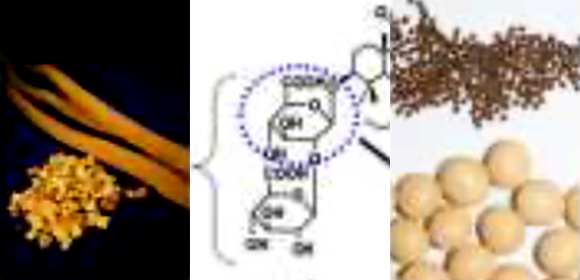
Newly discovered enzyme helps make valuable bioactive saponins
Osaka University-led research team discovers new enzyme, opening novel routes for producing a family of valuable chemicals with medical and food uses
Many plants, including legumes, make naturally occurring chemicals called saponins. For example, the medicinal plant licorice produces the saponin glycyrrhizin, a potent natural sweetener that also has antiviral and other pharmacological activity. Soyasaponins, found in soybeans, have anticarcinogenic and antioxidant properties.
But exactly how plants make these useful products was unclear. Now a research team at Osaka University, in collaboration with National Agriculture and Food Research Organization (NARO), RIKEN, and Chiba University, has uncovered a vital link in the complex biochemical pathway for saponin synthesis. Their discovery paves the way for improving the commercial production of these high-value products. The team recently published the study in Nature Communications.
Osaka University researchers Soo Yeon Chung and Hikaru Seki, with collaborators in NARO (Masao Ishimoto et al.), RIKEN, and Chiba University, studied co-expression gene network of saponin synthesis using technologies including gene cloning and sequence comparisons, coupled with biochemical analyses in mutants and genetically modified plants of a model legume species. They discovered a new enzyme in the CSyGT family that are similar in structure to the enzymes producing cellulose in plant cell walls. Unexpectedly, they showed that the new member of the family was responsible for a key step in saponin synthesis, where a sugar molecule is attached to the triterpenoid backbone. This discovery challenged the generally accepted view that a different class of enzyme was probably involved in this step.
They went on to insert the gene for the newly discovered CSyGT enzyme, along with genes for other steps in the biochemical pathway, into yeast cells. The engineered cells successfully produced glycyrrhizin from simple sugars, indicating a potential route for industrial manufacture of valuable saponins by growing yeast cells on a large scale.
“Our multi-disciplinary team showed, for the first time, that this type of enzyme is important in saponin synthesis,” says corresponding author Toshiya Muranaka. “Our results fill a gap in previous knowledge and also challenge the accepted view of how this pathway for biosynthesis operates.”
“We showed that yeast cells can make glycyrrhizin when we insert the necessary plant genes,” explains Chung. “This offers the prospect of new ways to produce these valuable substances commercially, and to generate completely novel types of saponin that might have further beneficial applications in medicine or the food industry.” Seki adds, “producing the chemicals in cell cultures would also reduce the need to deplete natural plant resources and so help to meet the vitally important Sustainable Development Goals.”

Fig. 1 Engineered biosynthetic pathway for production of glycyrrhizin in yeast.
The complete glycyrrhizin biosynthetic pathway was constructed by expressing β-amyrin synthase (βAS), two cytochrome P450s (CYP88D6 and CYP72A63), CSyGT, UGT73P12 and UDP-glucose dehydrogenase (UGD) in yeast. The engineered yeast utilizes endogenous metabolites (2,3-oxidosqualene and UDP-glucose) as substrates, and thus able to produce glycyrrhizin from simple sugars.
The article, “A cellulose synthase-derived enzyme catalyses 3-O-glucuronosylation in saponin biosynthesis”, was published in Nature Communications at DOI: https://doi.org/10.1038/s41467-020-19399-0 .
Related Links
